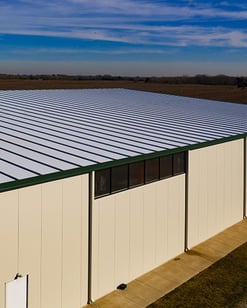While commercial building is projected to lag the red-hot residential market in 2021, there will be some bright spots with a growing demand for warehouses and data centers.
“Warehouse construction will be the clear winner as e-commerce giants continue to build out their logistics infrastructure. Office starts will also increase due to rising demand for data centers,” according to the Dodge Data & Analytics’ 2021 Construction Outlook.This is good news for contractors that specialize in low-slope roof projects which command more than half of a commercial roofing market that has reached nearly 2 billion square feet, and could expand by another 1 billion square feet by 2025.
Increasingly insulated metal panels (IMP) are proving the roofing material of choice as they provide value on low-slope roof projects, saving builders time and money, while being environmentally-friendly and structurally-sound.
Steel Steals the Show
IMPs like Green Span Profiles’ RidgeLine, with exterior and interior panels made of galvanized and stainless steel, are fueling demand with the North America steel roofing market estimated at $2.58 billion in 2018.
According to Grand View Research, “Steel roofs are long-lasting and  durable building materials that provide significant energy saving to end-use applications.”
durable building materials that provide significant energy saving to end-use applications.”
Traditionally IMPs were used for walls and roof cladding to create high-performing weather barriers, but thanks to advances, IMP can now act as structural support.
According to a Dec. 1 Metal Construction News article: “With the proper fastening and design, the shear load capacity of insulated metal roof decks are comparable to 1.5-inch-deep, 22-gauge B deck systems but without the need for welding decking to framing.”
All IMPs are foamed in place with an insulating foam core surrounded by an outer and inner steel facing. RidgeLine, for example, is a 2-3/8-inch tall mechanically seamed roofing panel covering 42 inches, with thickness options of 2.5, 3, 4 and 5 inches. The core is a continuously poured-in-place, polyisocyanurate insulating foam.
Low-Slope Roof Projects Needs
Low-slope roofs are in the niche between steep-slope or conventional slope roofs and flat roofs.
While conventional slopes on roofs is 4:12 and steeper (4 inches of slope for every foot of run), low-slope roofs are between 2:12 and 4:12 with a typical rise of 3 inches for every foot of run.
Flat roofs (which hopefully are never actually flat!) have a slope that is up to 2:12.
When designing a low-slope roof, builders need to keep several performance factors in mind, including:
- Wind
- UV rays
- Freezing and thawing
- Expanding and contracting
- Remaining watertight
The RidgeLine, like many IMPs, provides a double layer of weather-tight protection as it is designed to resist water infiltration under hydrostatic pressure, and has standing seams, which raise the joint between panels above the water line.
In addition, the RidgeLine panel system is installed with a factory-caulked batten to add another layer of water protection.
Benefits of IMPs on Low-Slope Roofs
The benefits of IMPs start by design with a high R-value built into the panel making them an energy efficient choice for any project.The RidgeLine has insulation of R-8 per inch, more than twice the normal R-value of fiberglass insulation per inch. The RidgeLine range is R-20 for 2.5 inches to R-40 for 5 inches.
Other benefits off IMPs for low-slope roof projects includes:
Saves Time and Money: The single component installation of IMPs saves manpower and resources vs. traditional low-slope roof deck construction that requires B-deck, vapor barriers, insulation layers, and cover board. Smaller crews can complete the project saving money.
Meets Newer Energy Codes: Many states and localities are putting in regulations that require energy-efficient materials for projects. IMPs meet these demands and have the potential for federal, state, and local green tax incentives.
Sustainability: IMPs are partly composed of recycled steel and are 100 percent recyclable. The composite nature of IMPs means fewer vehicle miles and on-site waste during installation.
If you need advice on using insulated metal panels for your next low-slope roof project, contact Green Span Profiles today and our business, engineering and technical specialists can help you find the right fit.






